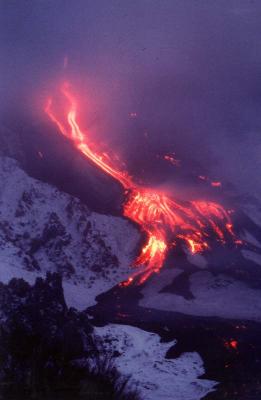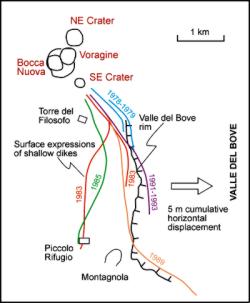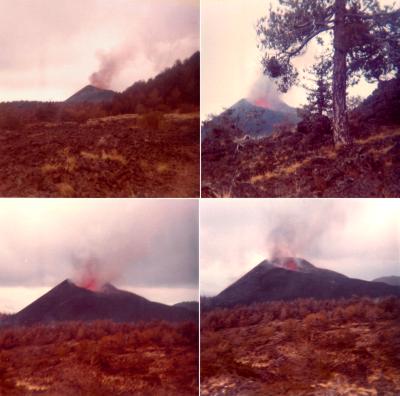 |

Lava
flows fed by a lateral eruption are seen spilling down the southwestern
slope of Valle del Bove in December 1991. Photo by Carmelo Monaco
|
|
Flank
Eruptions
Mount
Etna erupts both from the summit craters and from vents away from the
summit craters, which are generally considered flank vents. It has been
correctly observed that some activity on the flanks appears to be closely
related to the summit craters, and thus to the central conduit system.
In these cases, flank activity is almost always preceded by increased
summit activity by days to months, and summit activity ceases once flank
eruption has begun, or changes from Strombolian-effusive to strong degassing,
often carrying some ash. Flank vents may form, in this type of eruption,
very close to the summit and practically "take over" their
activity, as has occurred in February 1999. This type of activity, which
may continue for months or even years, is the classical "subterminal"
eruption as defined by the volcanologist Rittmann, and is nothing else
than some kind of summit activity, even though occurring from vents
outside the summit craters. The output is generally fairly low (from
less than one cubic meter per second to a few cubic meters per second)
and is considered to represent the mean rate at which magma is ascending
to the surface from depth. It should be noted, though, that this magma
ascent rate is not all too regular.
"LATERAL"
ERUPTIONS
The opening of vents still further downslope, but in a manner extremely
similar to that of the "subterminal" eruptions, leads to what
has been named "lateral" eruptions by Rittmann and other authors.
As in the "subterminal" eruptions, the activity is very closely
related to the central conduit system, and degassing frequently takes
place through one or more of the summit craters rather than from the
flank vents themselves (e.g., the 1989 eruption).
The fissures of these eruptions are arranged more or less radially to
the summit, but are strongly controlled by the tectonically induced
fracture systems within the volcano, most notably the east-northeast
and southeast systems.
The output during these eruptions is considerably higher than that of
"subterminal" activity, especially during their initial stages.
The higher output results mostly from the pressure of the hydrostatic
head - that is, the magma still present in the central conduit system
above the elevation of the new eruptive vents - but to some degree
may also reflect the fact that magma rises easier to the lower elevation
than to the summit area. As long as magma continues to drain from the
central conduit system above the flank eruptive vents, the output remains
quite high (considerally above the average of about 10 cubic meters
per second for flank eruptions) while it drops to average levels or
below once the level of magma in the central conduit system has sunken
to the level of the active vents.
It is very difficult to make a clear distinction between "subterminal"
and "lateral" eruptions because there is an uninterrupted
gradation between both end members and in their characters (apart from
the eruption rate), they are essentially identical. This difficulty
becomes apparent in the case of the 1975-1977 effusive activity on Etna's
north flank, often cited as a typical "subterminal" eruption
(it was clearly related to the NE Crater with which it had alternating
phases of activity). The eruptive vents lay at elevations as far down
as 2600 m, not much higher than the March-July
1985 fissure (2600-2500 m) on the south flank. However, the effusion
rate was very low (less than one cubic meter per second). So was this
a flank eruption, as Murray (1990) and Azzaro and Neri (1992) believe,
or is it rather to be considered an extension of the persistent summit
activity at NE Crater, initiated in 1974? If the effusion rate is taken
as the decisive parameter, then the 1975-1977 activity is summit eruption
rather than flank eruption.
Dike
intrusions near Valle del Bove since 1978
 This map shows
the traces of dikes emplaced on the upper southeastern flank of
Etna between 1978 and 1991, as inferred from deformation measurements.
The 1978-1979 dikes have been projected from the eruptive fissures
of the four eruptive episodes during those years, no precise geophysical
data about the position of the dikes are available. Note that all
dikes begin at the Southeast Crater (SE Crater). The map originally
appeared in McGuire et al. (1997) and has been slightly modified.
This map shows
the traces of dikes emplaced on the upper southeastern flank of
Etna between 1978 and 1991, as inferred from deformation measurements.
The 1978-1979 dikes have been projected from the eruptive fissures
of the four eruptive episodes during those years, no precise geophysical
data about the position of the dikes are available. Note that all
dikes begin at the Southeast Crater (SE Crater). The map originally
appeared in McGuire et al. (1997) and has been slightly modified.
|
|
What
causes such eruptions? There are two main reasons for these eruptions
to occur. One is the response of the volcano and its fracture systems
to variations in the volume of magma rising within the central conduit
system. The uprise of a voluminous "batch" of magma, especially
when gas-rich, may notably increase the hydrostatic pressure on the
conduit walls and cause the mountain to fracture radially, in a process
where magma injection into the flanks is active and fracturing
is passive. The other process which may lead to "lateral"
erputions is a change in the structural stability of the volcano, caused
by tectonic movements. A decrease in the structural stability of the
volcano may generate fractures at depth into which magma can intruce
more or less passively, and there it may remain for weeks before it
erupts, as supposedly occurred in 1991, before the 1991-1993
flank eruption.
The intrusion of magma into fractures radiating away from the central
conduit system forms dikes (or dykes) which do not necessarily
have to reach the surface to produce eruptions, but may also remain
at depth and cool. It has been suggested by some authors that dikes
may actually serve as temporary storage areas, for periods of up to
many years, but Murray (1990) rejected such hypotheses based on the
assumption that in a dike, magma cools relatively rapidly and therefore
cannot remain available for eruption for more than a few months.
It is, however, well possible that in some areas within the mountain,
close to the central conduit system, the environment is so hot that
it would allow a magma much longer to remain fluid in a dike than close
to the surface and farther away from the central conduit system.
The
evolution of a "lateral" eruption from the initiation of dike
intrusion to the arrival of magma in a newly opening eruptive fissure
has been documented extraordinarily well in 1983 on Etna's south flank
(Murray and Pullen 1984). The path of the subterranean dike, as it propagated
towards the eruption site, could be followed by monitoring the ground
deformation (a levelling network was set up in the area by John Murray
and his colleagues months before, because an eruption was considered
likely to occur there in the future). It was striking to see that, although
there was no activity at the SE Crater before and during the 1983 eruption,
the dike originatted from a point very close to that crater, at a depth
of about 1 km. For the first kilometer, the path of the dike ran parallel
to the fractures of 1978 and 1979 eruptions, then, east of Torre del
Filosofo, it split into two branches, one continuing straight southeastwards
while the other turned southwestwards, and then, still another kilometer
downslope, southwards. The southeastern branch turned south at Belvedere
and ended somewhere to the south without reaching the surface.
The western branch eventually passed below the Piccolo Rifugio (the
building was traversed and heavily damaged by the non-eruptive part
of the fracture) and little further downslope the top of the dike intersected
the surface, and an eruptive fissure became active.
Although
until 2001 the path of a feeder dike for a flank eruption was never
again traced in as much detail as in 1983, geophysical monitoring has
allowed the documentation of further intrusions in other cases thereafter.
All flank eruptions during that period through 2001 thus seem to originate
from the SE Crater, only one intrusion which did not result in a flank
eruption, in September 1986, originated at the NE Crater (Murray 1990).
Some were, in fact, characterized by the slow draining of the central
conduit system (1983, March-July 1985, 1986-1987, 1991-1993) while others
were caused by the fracturing of the volcano under the hydrostatic pressure
of a newly arrived, voluminous and gas-rich batch of fresh magma (e.g.,
1989). In 2002, eruptive activity on the Northeast Rift was again closely
related to the NE Crater, while activity on the S flank during the same
eruption was completely independent of the central conduit system.

A typical
eccentric eruption at Etna occurred in early 1974 on the western flank
of the volcano. These amateur photos, taken by Renato Bernardini (University
of Catania), show a small cinder cone growing by intense Strombolian
activity amidst a forest, February 1974.
"ECCENTRIC"
ERUPTIONS
Eccentric eruptions
are thought to be the result of dikes rising vertically from depth to
the surface, which are not directly related to the central conduit system.
Such eruptions are quite rare and therefore only two - in 2001
and in 2002-2003 - have been documented
in much detail by modern geophysical monitoring techniques. Previous
eruptions of this type occurred in 1974 on
the western flank, forming two small cones named Monti De Fiore,
and in 1892, when the Monti Silvestri craters came to existence. Many
of the more remote pyroclastic cones on the flanks of Etna seem to be
the products of such eruptions. In the case of the 1974 Monti De Fiore,
the 1892 Monti Silvestri and 1763 Montagnola eruptions it is well documented
that the summit activity was in no way affected by the flank eruptions;
in July 1893 incandescent lava was seen flowing within the Central Crater
only 7 months after the end of the voluminous Monti Silvestri eruption.
Eccentric eruptions are generally characterized by a much higher degree
of explosivity and thus build pyroclastic cones of appreciable dimensions.
Unlike "lateral" eruptions during which most degassing occurs
though the summit craters, many eccentric eruptions are not accompanied
by similar summit activity, and sometimes they are neither preceded
by summit activity (e.g., 1892); in other cases summit activity that
has begun before an eccentric eruption continues with little variation
during and after that eruption, as in 1974. However, the 2001 and 2002-2003
eruptions were notable exceptions because in this case summit, lateral
and eccentric activity occurred simultaneously. It seems that the uprise
of an eccentric dike destabilized the volcanic edifice to the point
that the opening fracture system affected the central conduit system,
triggering a lateral eruption. This does not seem to be the case in
most eccentric eruptions.
While eccentric eruptions may possibly occur in any spot on the volcano
(that is, in all the area between its very base and the summit), eccentric
vents are nearly always aligned along the same, essentially subradial,
trends as lateral eruptive fissures. This is due to the fact that the
uprise of eccentric dikes is facilitated along lines of structural weakness,
which may be of regional tectonic origin or related to the more surficial
volcano-tectonic stress field. Thus the eccentric vents of the 2001
and 2002-2003 eruptions on the south flank were formed on the same trend
as some previous lateral eruptions as those of 1983 and March-July 1985.
In
spite of the enormous amount of new data provided by the 2001 and 2002-2003
eruptions, the problem of eccentric eruptions remains full of mysteries.
Do the conduits feeding such eruptions originate in a rather "individual"
manner from the deep storage area, or do they depart, still at considerable
depth, from the roots of the central conduit system? And which of the
eruptions of the past centuries were eccentric, which were lateral?
Is there a reliable method allowing to distinguish whether past eruptions
were eccentric or lateral? Possibly the explosivity of those eruptions,
which can be read from the size of the related cones, is an important
indicator, and the chemical composition of their products may be another.
Research in this field is not only of academic interest, but has important
implications for hazard assessments at Etna. If eccentric eruptions
are always as explosive as those of 2001 and 2002-2003, they represent
a significant hazard to human infrastructures and traffic. It is therefore
necessary to understand how frequent such eruptions are in the long
and short term. During the 110 years before the 2001 eruption there
had been only one single eccentric eruption, which furthermore was studied
by an earlier generation of scientists, and before most of the current
concepts of Etna's dynamics were developed. At the beginning of the
new millennium eccentric eruptions thus received very little - if any
- attention and were not even mentioned in most publications of the
20 years preceding the 2001 eruption.
In the opinion of researchers of the 19th century, some of the remote
flank cones of Etna - such as the isolated Monte Moio cone complex on
the northern flank, and Monte Barca immeidately south of Bronte, on
the western flank - were true volcanoes on their own, a view that is
still maintained by many inhabitants of villages on Etna's flanks close
to the more remote of the flank cones. During a recent visit to the
town of Randazzo, I talked with residents who recalled the dramatic
1981 north flank eruption, which seriously
threatened their home town, as "a new volcano that exploded just
over here" - and the 1981 eruption was not even an eccentric one!
Anyhow, there are no other individual volcanoes than Etna in the region,
and all cones are clearly products of Etnean volcanism. They merely
represent a further complexity in the outstandingly complicated picture
named "ETNA".
|



